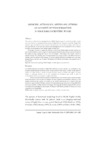Mostrar el registro sencillo del ítem
Medicine, Astronomy, affixes and others: an account of verb formation in some Early Scientific works
| dc.contributor.author | Crespo, Begoña | |
| dc.contributor.author | Moskowich, Isabel | |
| dc.date.accessioned | 2016-05-16T16:16:21Z | |
| dc.date.available | 2016-05-16T16:16:21Z | |
| dc.date.issued | 2006 | |
| dc.identifier.citation | Crespo, Begoña y Moskowich, Isabel: Medicine, Astronomy, affixes and others: an account of verb formation in some Early Scientific works. Selim 13 (2005-2006), p. 181-200 | es_ES |
| dc.identifier.issn | 1132-631X | |
| dc.identifier.uri | http://hdl.handle.net/2183/16675 | |
| dc.description.abstract | [Abstract]The patterns of derivational morphology found in Middle English in general should, theoretically, coincide with those found in an emerging functional variety of English from the same period (scientific writing). This scientific register has only been studied as such in the last decade or so, and often receiving a brief mention in more general works. At the same time, derivational morphology has not been considered as a tool to measure the degree of vernacularisation of late Middle English scientific texts. In this paper we intend to examine the behaviour of verbs in late Middle English scientific texts from the point of view of derivation and the degree of vernacularisation observed in them (previous work has focused on the analysis of nouns, arguing that they are the most frequent word-category with semantic content in scientific writing). The particular aspect of vernacularisation that concerns us here is the ability of writers to reanalyse and re-use elements of the language. To ascertain whether all fields of knowledge resort to the same linguistic devices, whe have used Chaucer’s The Equatorie of the Planetis and Astrolabe and compared it with a Remedy Book. | es_ES |
| dc.description.abstract | [Resumen] Los modelos derivativos encontrados en Inglés Medio deberían, en teoría, coincidir con los hallados en una incipiente variedad funcional del mismo periodo (el inglés científico). Este registro científico ha sido objeto de estudio en la última década, a menudo, recibiendo una breve mención en trabajos más amplios. Al mismo tiempo, la morfología derivativa no ha sido considerada una herramienta para medir el grado de vernacularización de los textos científicos en inglés medio tardío. En este artículo pretendemos examinar el comportamiento de los verbos en textos científicos de inglés medio tardío desde el punto de vista de la derivación así como el grado de vernacularización observado en ellos (trabajos anteriores se han centrado en el análisis de los nombres aduciendo que son la categoría léxica más frecuente en inglés científico). El aspecto concreto de la vernacularización que nos interesa es la capacidad de los autores para reanalizar y reutilizar elementos de la lengua. Para comprobar si todos los campos del saber recurren a los mismos procesos lingüísticos, hemos usado The Equatorie of the Planetis y Astrolabe de Chaucer y lo hemos comparado con un Remedy Book. | es_ES |
| dc.language.iso | eng | es_ES |
| dc.publisher | Universidad de Oviedo, Servicio de Publicaciones | es_ES |
| dc.subject | Medicine | es_ES |
| dc.subject | Astronomy | es_ES |
| dc.subject | Early Scientific works | es_ES |
| dc.subject | Middle English | es_ES |
| dc.subject | Derivational morphology | es_ES |
| dc.subject | Scientific register | es_ES |
| dc.subject | Vernacularisation | es_ES |
| dc.subject | Morfología | es_ES |
| dc.subject | Derivación | es_ES |
| dc.subject | Inglés Medio | es_ES |
| dc.subject | Registro científico | es_ES |
| dc.subject | Vernacularización | es_ES |
| dc.title | Medicine, Astronomy, affixes and others: an account of verb formation in some Early Scientific works | es_ES |
| dc.type | info:eu-repo/semantics/article | es_ES |
| dc.rights.access | info:eu-repo/semantics/openAccess | es_ES |
| UDC.journalTitle | SELIM Journal of the Spanish Society for Medieval English Language and Literature | es_ES |
| UDC.issue | 13 | es_ES |
| UDC.startPage | 181 | es_ES |
| UDC.endPage | 200 | es_ES |
Ficheros en el ítem
Este ítem aparece en la(s) siguiente(s) colección(ones)
-
GI-MUSTE - Artigos [41]






